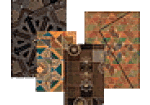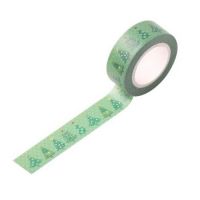Kirikane (DELETED)

Precision Informed by Devotion
Kirikane ("cut ") refers to the ancient technique of decorating Buddhist artwork and statues with gold metal leaf. Traditional kirikane involves heating and bonding together six extremely thin sheets of gold leaf, then using a bamboo knife to cut out fine strips or designs such as diamonds or triangles. Glue made from hide ("nikawa") or seaweed ("funori") is used to attach these shapes to the object being decorated.
With the earliest known kirikane artifact dating to 529 CE, the art form truly flourished in Japan between the 11th and 13th centuries. Due to the painstaking and time- consuming nature of its process, kirikane began a gradual decline in the following years. Devoted kirikane revivalist Sayoko Eri (1945-2007) applied the traditional art form to everyday items such as boxes and screens as well as to Buddhist artifacts. Our cover designs reproduce the decorative patterns of Sayoko Eri's work using our unique printing process.
Kirikane ("cut ") refers to the ancient technique of decorating Buddhist artwork and statues with gold metal leaf. Traditional kirikane involves heating and bonding together six extremely thin sheets of gold leaf, then using a bamboo knife to cut out fine strips or designs such as diamonds or triangles. Glue made from hide ("nikawa") or seaweed ("funori") is used to attach these shapes to the object being decorated.
With the earliest known kirikane artifact dating to 529 CE, the art form truly flourished in Japan between the 11th and 13th centuries. Due to the painstaking and time- consuming nature of its process, kirikane began a gradual decline in the following years. Devoted kirikane revivalist Sayoko Eri (1945-2007) applied the traditional art form to everyday items such as boxes and screens as well as to Buddhist artifacts. Our cover designs reproduce the decorative patterns of Sayoko Eri's work using our unique printing process.
- No products found.
153
Loading






